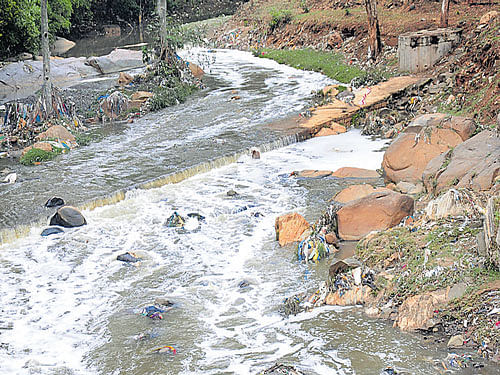
Vrushabhavathi Valley, a tributary of Arkavathi river that flows through Bengaluru, is in dire neglect. A study conducted recently by Bangalore University (BU) on odour management of the valley has concluded that more plants are needed to treat the sewage water flowing through it.
“We did a study on how to manage the odour emanating from the Vrushabhavathi waste water and found that the root cause for the foul smell is hydrogen sulphide which is colourless and odourless. The foul smell is that of rotten eggs. It’s poisonous, odourless, flammable and explosive,” Nandini N, Chairperson, Department of Environmental Science, BU, told Deccan Herald.
The lone STP functioning at present isn’t enough. The treatment plants in the City are able to address just 60 per cent of the problem. There is a need to treat the polluted water flowing in the valley as it streams towards Ramanagar and Mysuru.
On the way, many farmers use it for irrigation and cattle-rearing. “The produce is consumed by Bengalureans. So, the government should buildmore STPs of at least of 5-10 MLD capacity each,” she said.
Besides, the professor went on, the treatment plants in peripheral and rural areas should be upgraded as the contaminated water gets mixed into this valley water. A full-fledged treatment plant with grit chambers, pH correction, anaerobic digester, primary clarifier, flocculation chamber, aeration chamber, secondary clarifier and stay pond should be created and installed, she said.
Vrushabhavathi is a tributary of Arkavathi river which joins Cauvery. The river drains a major part of western Bengaluru’s waste water — domestic as well as industrial — covering an area of 97 sq km. It carries around 2,300 metre cube per hour of urban and domestic discharge. It also carries seasonal discharge to Byramangala reservoir.
People living in Magadi Road, Mysuru Road and around the valley are fed up with the foul smell and want the new corporators to solve the problem.
“The open drain is a deathtrap. The area around it isn’t well lit and covered. The BBMP and the BDA have desilted it and cleared encroachments on it , but with little success. The government must clean and fence it and ensure there is no more foul smell,” said Sanjay L, a resident of Rajarajeswari Nagar.